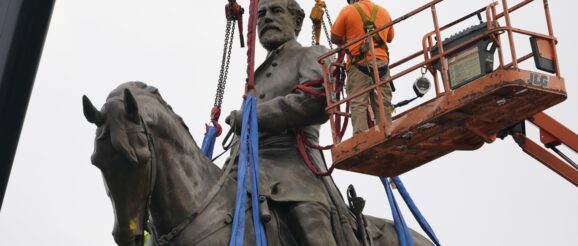President Trump wants to restore monuments. Will that happen?

President Trump signed an executive order on Thursday aimed at “restoring truth and sanity to American history” – decrying what the order characterized as efforts to “undermine the remarkable achievements of the United States by casting its founding principles and historical milestones in a negative light.” The order calls for the removal of “divisive race-centered ideology” from the Smithsonian’s museums and research centers. It also calls on the Secretary of the Interior to restore public monuments, statues and other markers that have been removed or changed since 2020. But it’s unclear how many sites — and which ones — will be impacted by the executive order.


The order also directs the Department of the Interior to ensure that any monuments, statues or memorials under its jurisdiction “do not contain descriptions, depictions, or other content that inappropriately disparage Americans past or living (including persons living in colonial times), and instead focus on the greatness of the achievements and progress of the American people or, with respect to natural features, the beauty, abundance, and grandeur of the American landscape.”
A national reckoning on race – and monuments to the past – grew after George Floyd was killed by police in 2020. More than 200 public Confederate symbols across the country were removed, relocated or renamed within about a year and a half, according to research by the Southern Poverty Law Center (SPLC). Seth Levi, Chief Program Strategy Officer of the SPLC, says many of these removals did not take place on lands under the Department of the Interior’s jurisdiction.
“Even for the objects that are on public land, it’s normally land that’s owned and controlled by municipalities or state governments. I’m not actually aware of any removals on National Park Service land,” Levi says. “There have been removals on land that’s controlled by the Department of Defense with the names of military bases, [but] it’s unclear to us how many monuments have already been removed that this would actually apply to.”
Though action from Thursday’s executive order might be limited for now, Levi says he believes the Trump administration is trying to “minimize the fact that enslavement was a huge part of our history” and that the contributions of racial minorities to American history “seem to be under threat.” He also points to SPLC data showing that historically, Confederate monuments and names on schools, roads and other sites grew in the U.S. during the beginning of the Jim Crow era and around the time of the landmark case Brown v. Board of Education, in which the Supreme Court ruled in 1954 that racial segregation in public schools is unconstitutional.
The National Park Service has already been revising its websites
Thursday’s executive order comes on the heels of other changes to National Park Service websites. After President Trump’s January executive order about gender ideology declared that “It is the policy of the United States to recognize two sexes, male and female,” the NPS removed all references to transgender people from the Stonewall National Monument website. Weeks later, it had deleted websites containing information about transgender activists like Marsha P. Johnson and Sylvia Rivera.


The National Parks Conservation Association, a nonpartisan group that advocates to protect national parks, issued a statement regarding Thursday’s order. “Across the country, our national parks protect vital American history, from the birthplaces of American presidents to the birthplaces of our democracy. Our parks tell stories from the civil rights movement, the Civil War, and beyond,” said Alan Spears, a senior director at the National Parks Conservation Association. “Every American who cares about our country’s history should be worried about what people, places, and themes disappear next.”
“You can’t control historical memory by controlling monuments,” says Thompson. “There’s so many people who tell their children other stories, who lead tour groups, who write books. There’s so many ways of learning about history that are not looking at some chunk of stone.”
